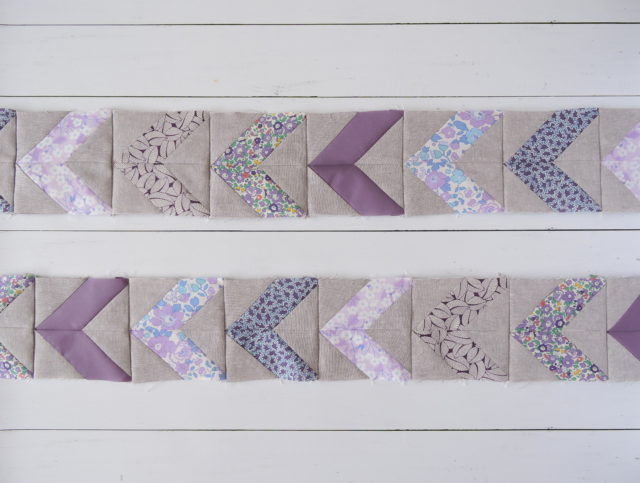What to do when your quilt rows don’t line up? When you’re working on a long-term project like Sunset Isle, where there’s an array of techniques and a variety of how many blocks per row is included, it’s not unusual to get to the end and find that your rows don’t quite all match up in length.
Perhaps it’s that seam allowances have changed over the year as you’ve grown more confident in your abilities and your accuracy has improved. Perhaps the printer settings were wrong when it came time to print templates for a row. And it’s probably the fact that some rows include a heckuva lot more seams across the length than others! If you’re just a millimetre out on each seam… multiply that by 30 vertical seams and that’s going to be a half inch difference to a row with only 15 vertical seams.
So how do you make it work without having to have a major unpicking session?
I am all about “make it work” when it comes to these things. Unless it’s a quilt that’s going to be entered in a show, it does not matter if things aren’t 100% perfectly accurate. It does not matter if you add in a little bit of extra fabric to make things fit or chop off a point to save an hour of unpicking.
And that’s coming from a reformed perfectionist! Quilting has done wonders in helping get over some very strong perfectionistic tendencies. A finished, imperfect quilt is better than a deserted, unfinished quilt top.
When it specifically comes to Sunset Isle quilt tops, here’s three suggestions to Tim Gunn your quilts and make it work.
Add extra background fabric to the shorter rows
If you have a few rows that have come up short, adding some extra fabric to each end of the row will help bring it up to size and keep it symmetrical.
- Measure the length of the longest rows – L”.
- Measure the length of the shorter row – S”.
- Find the difference between the longest and shorter row (L minus S) and divide that number by 2 to find out how much extra to add to each side – E”.
- Add ½” to E” for a seam allowance, and cut two pieces that are as tall as the row.
For example: the longest row (L) is 61”, and the shorter row is 58.5” (S).
L – S = 2.5
2.5 ÷ 2 = 1.25” (E)
E + ½” = 1 ¾”
The shorter row is 4 ½” tall, so you would cut two pieces measure 1 ¾” x 4 ½” and sew one piece to each end of the row to make it 61”.
Add a border
Perhaps your quilt rows aren’t too badly out of line – adding a border is a great way to make those uneven edges disappear. Centre the rows and sew them together as best as you can, and then add a border or two. This is also a great way to make a quilt just that little bit bigger too!
Just sew it together and celebrate
You know what? Maybe it doesn’t even bother you that your rows aren’t “perfect”… perfection is overrated! You are proud of what you’ve accomplished and you’re just going to get it done and finished and into your household’s quilt usage circulation. I love that attitude!
Whatever method you choose is valid. Whatever you decide to do with your quilt top is an appropriate way to finish your quilt. It is your quilt and what you do with it is the right choice. Don’t let the hypothetical quilt police AKA our inner critics dictate what we should or shouldn’t do. Go forth and Make It Work!

Kay says
I feel like I fudge everything I do but a least they get finished and sometimes I am just happy with that. x
Alyce says
Finished is better than a growing piles of imperfect tops!
Joni says
I’m definitely in that last category!! But I didn’t have *too* many problems with Sunset Isle. Thanks for another great QAL!!
Alyce says
I’m glad to hear it!
Cheryl says
Thank you for these suggestions. I found your post while looking for ideas on how to fix a current, similar quilt project. I was tempted to just toss all the rows into a large bag and shove it in a closet.
Alyce says
Oh that’s wonderful to hear!
Deb Griggs says
Thank you for helping me quiet the quilting police in my life💘
Alyce says
You are so welcome!